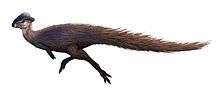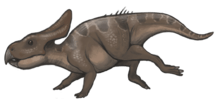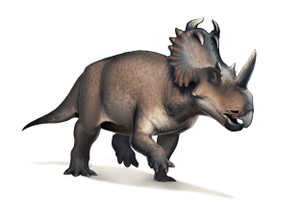Unescoceratops
Unescoceratops is a genus of leptoceratopsid ceratopsian dinosaurs known from the Late Cretaceous of Alberta, southern Canada. It contains a single species, Unescoceratops koppelhusae.[1]
| Unescoceratops | |
|---|---|
| Scientific classification | |
| Kingdom: | Animalia |
| Phylum: | Chordata |
| Clade: | Dinosauria |
| Order: | †Ornithischia |
| Family: | †Leptoceratopsidae |
| Genus: | †Unescoceratops Ryan et al., 2012[1] |
| Species: | †U. koppelhusae |
| Binomial name | |
| †Unescoceratops koppelhusae Ryan et al., 2012[1] | |
Discovery
Unescoceratops is known only from the holotype specimen TMP 95.12.6, a partial left dentary. The fossil was collected in 1995 in the Black Coulee locality (formerly Deadhorse Coulee), near the Writing-on-Stone Provincial Park, from the Dinosaur Park Formation, dating to the late Campanian stage of the Late Cretaceous period, about 76.5-75 million years ago. The specimen was regarded as too incomplete to identify, and was shelved for several years. It was believed to be a Leptoceratops specimen at the time. A cladistic analysis done by Michael Ryan (of The Cleveland Museum of Natural History) and David Evans (of the Royal Ontario Museum) found it to be among the most advanced leptoceratopsid genera.[1][2][3]
Description
Unescoceratops is thought to have been between one and two meters long and less than 91 kilograms. Its teeth were the roundest of all leptoceratopsids.[3]
Mallon et al. (2013) examined herbivore coexistence on the island continent of Laramidia, during the Late Cretaceous. It was concluded that small ornithischians like Unescoceratops were generally restricted to feeding on vegetation at, or below the height of 1 meter.[4]
Etymology
The genus Unescoceratops was first described by Michael J. Ryan, David C. Evans, Philip J. Currie, Caleb M. Brown and Don Brinkman in 2012 (though it had been published earlier by Ryan and Currie in 1995 with no name) and the type species is Unescoceratops koppelhusae.[1] The name means "UNESCO's ceratopsian" (ceratopsian means "one with a horned face"). The name is meant to honor UNESCO's efforts to increase understanding of natural history sites around the world. "Dinosaurprovincialparkaceratops was too long," explained Ryan.[2]
See also
References
- Ryan, Michael J.; Evans, David C.; Currie, Philip J.; Brown, Caleb M.; Brinkman, Don (2012). "New leptoceratopsids from the Upper Cretaceous of Alberta, Canada". Cretaceous Research. 35: 69–80. doi:10.1016/j.cretres.2011.11.018.
- Ryan, Michael (2012). New horned dinosarus named (SWF) (YouTube video). Cleveland: Cleveland Museum of Natural History. Retrieved 30 Mar 2012.
- Brown, Mark. "Two new dinosaur species fill in evolutionary gaps". Wired. Retrieved 7 April 2012.
- Mallon, Jordan C; Evans, David C.; Ryan, Michael J.; Anderson, Jason S. (2013). "Feeding height stratification among the herbivorous dinosaurs from the Dinosaur Park Formation (upper Campanian) of Alberta, Canada". BMC Ecology. 13: 14. doi:10.1186/1472-6785-13-14. PMC 3637170. PMID 23557203.


